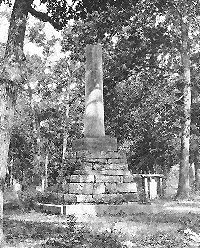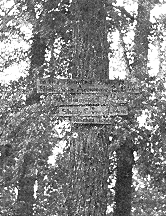The
Natchez Trace, By John Swain (continued)

|
To visit a shrine
which should be ever sacred to lovers of the winderness - The tomb of the
intrepid young explorer, Meriwether Lewis
|
|
And as I went on my way after
breakfast—yet before six in the morning—he assured me that there was nothing
to pay, but that he was willing to have the boot on the other foot for
the privilege of hearing what was happening in the world without.
The Trace was a familiar road to Slater,
and he gave me directions for following it through Kinderhook, once a settlement
but now a deserted store, and so by Pigg Hill and the ridge above Jones's
Creek and Leatherwood, to Gordon’s Ferry on Duck River. Never have my feet
traveled a more grateful way than the level boulevard upon the ridges into
which he directed me. Narrow and winding, but shaded and firm it was, and
at frequent intervals some lover of history had nailed upon the trees boards
bearing the legend: “Natchez Trace.”
Gordon’s Ferry is gone now, and a big
iron bridge above the ancient ford bears travelers across Duck River. Once
over it one mounts to the hilltop again steeply, and so by a pleasant walk
comes down to Shady Grove, of happy name but unsavory memory. I fell in
with one of “Fighting Joe” Wheeler’s old troopers there, and dined well
at his house. He knew my road from the Cumberland to the Mississippi, and
had ridden every foot of it, and told glowing yarns of cavalry excursions
along it. But when I mentioned John Morgan as one who might have come that
way, the trooper's wife answered while the old man smiled.
“Yes,” she said, “John Morgan came up
this road once. I remember it well. Noted it at the time. It was the only
time I ever knew him to stop for a road. Usually he came up the hill on
one side and down the other. Any country was good enough for Morgan, road
or no road.”
I went up to the higher hills after
dinner, and through the quaint little hamlet of She Boss—where my prophet
predicted failure— and then, where the Trace suddenly turned to one side
and dropped to the valley to cross the Kettle Gap, I kept ahead on the
hilltop, and went on to my confusion in the Sunrise Branch.
It was Dick Bates who set me right
when I had almost become web-footed, and kept me overnight and to breakfast,
and set me on my way with the assurance that he never yet had let any man
pay him for staying in his house.
Blessed is the way that leads to Little
Swan, and yet like other roads to happy lands, it is hard to travel. Back
and forth through the sparkling waters of Big Swan Creek I waded that day,
over sharp stones and heavy sandbars. I followed dim paths from ford to
ford, or now and then a roadway, seeking ever the trail to Palestine and
the forgotten site of Newburg. Somewhere on the hills up there was a marble
shaft on a granite pedestal to the memory of young Lewis, and that I sought.
Slater had heard of it. Bates remembered
that it was “plumb in the middle of Lewis County,” but didn't know who
was buried there. As I neared Palestine I met at last a teamster who twenty
years before had explored up that way and had seen it.
“Some chap was murdered up there,” he
said. “The place is ha’nted.” He didn't remember just where it was. “Keep
on up Swan to Little Swan, and when you get up to the head of that, you
cross the Trace again. Take the Trace Road, and when you get about two
miles this side of Newburg—only the town ain’t there any more—it’ll be
up to one side in the woods, like.”

|
A sign-board along
the Trace
|
|
With these definite directions
I wandered beside that beautiful creek. The mountainous hills grew higher
with every mile, and frowned gorgeously over the clear waters. The forest
grew more dense, the clearings smaller; and under bends of the bank, where
the water was deepest, handsome, foot-long brook-trout sported in full
view. Oh, it was a day to remember, this on Little Swan, and almost at
the end of it, when my feet were sore and my muscles weary, I came to Grinder’s
Creek and to the home of a woman who knew positively where the monument
was. Her house was the nearest dwelling to it—two miles and a half away.
“You take not that little hog-trail
by my fence,” she said, “nor that buggy-track across the creek, nor yet
that real, plain path; but if you're good at paths the’s a trail runs between
them and the creek. Take that up the creek, this side, till you come to
where some water dreens down out of the rocks. Take right up the p’int
there till you come to the hilltop, and strike back into the woods, and
you’ll find it.”
It was by such a way I went. The trail
was very faint, but the water “dreened down” over a beautiful shale cliff,
making a handsome cascade in a tiny, deep-green bower. I climbed the “p’int”
with difficulty and struck back into the woods till a certain smoothness
underfoot told me I was again on my road, forgotten here and never traveled,
cumbered at frequent intervals by fallen trees, but so grooved and packed
by a century of use that years of neglect could not efface it wholly. There
was still light to take a picture, though here and there a song-bird, beginning
his evening melody, accentuated the stillness. Suddenly I saw it,
dim and ghostly through the forest ahead, like the white specter of Lewis
himself, here where he was slain.
It is a simple broken shaft, on a pile
of rough granite that marks the ancient site of Grinder’s Tavern and the
grave
of the explorer. Half a hundred dilapidated gravestones surround it, relics
of the time when what life there was in this region CENTERed in the now-deserted
hamlet of Newburg. A little clump of aged apple-trees, looking strangely
out of keeping with their surroundings, and some run-wild shrubbery, show
that in the old days something of a garden was maintained about the “stand.”
To-day they seem to perform, with the gravestones, the task of keeping
alive the memory of those who knew and honored Meriwether Lewis. But the
monument itself, with this forest about it, silent, gloomy, deserted, represents
as nothing else could the love of solitude, the melancholia, the taciturnity
characteristic of the youth whose dust lies beneath it. Lewis’s spirit
indeed seems to pervade the spot, and it is little wonder that the hill
people believe it haunted.
Next
Back
|

